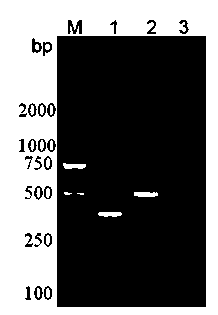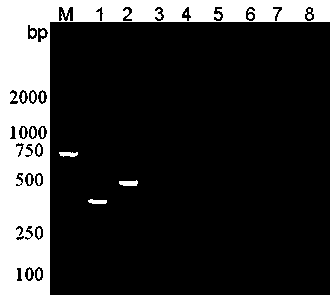Bacillus erysipelatos-suis PCR (Polymerase Chain Reaction) primer and application thereof
A technology of Erysipelas suis and porcine erysipelas, which is applied in the field of molecular biology and production, can solve the problems of economic loss of pig farmers and the incomplete purification of the disease, and achieve the effect of good specificity and high sensitivity
- Summary
- Abstract
- Description
- Claims
- Application Information
AI Technical Summary
Problems solved by technology
Method used
Image
Examples
Embodiment 1
[0020] (1) DNA extraction from samples to be tested: 1.5mL BHI culture solution containing G4T10 strain, 1.5mL BHI culture solution containing GD1201 strain, BHI culture solution was used as negative control, respectively follow the TIANGEN bacterial genomic DNA extraction procedure (extraction reagents were purchased from TIANGEN Company) and store the extracted DNA at -20°C.
[0021] (2) Add 1 μL DNA template to the PCR master mix to prepare a 25 μL reaction system and mix well.
[0022] PCR master mix: 1.5-3 μL of 10-fold diluted PCR buffer, 1.5-3 μL of dNTP mixture, 1 μL of Taq DNA polymerase at a concentration of 2.5M / μL, all shown in SEQ ID NO: 1-2 at a concentration of 10 pmol / μL 2 μL of each primer, ddH 2 O to make up 25 μL.
[0023] (3) Put the PCR reaction system in step (2) on a PCR instrument to perform cycle amplification reaction. The amplification conditions were as follows: pre-denaturation at 95°C for 10 minutes; then 30 cycles of 95°C for 30 s, 58°C for 30...
Embodiment 2
[0027] Example 2 specificity test
[0028] With the BHI culture solution containing G4T10 strain and the BHI culture solution containing GD1201 strain as positive controls, the BHI of Actinobacillus pleuropneumoniae, Haemophilus parasuis, Streptococcus suis, Escherichia coli suis and Pasteurella suis Culture fluid is carried out specific detection, uses the method and primer of embodiment 1, and detection result sees figure 2 . From figure 2 As can be seen from the results, except for the positive control, no bands could be amplified, and the positive disease materials amplified 379bp bands and 498bp bands respectively through PCR, indicating that the primers of SEQ ID NO:1~2 have a high specificity.
Embodiment 3
[0029] Embodiment 3 Sensitivity test
[0030] The DNAs of the two strains (G4T10 strain and GD1201 strain) extracted in Example 1 were serially diluted 10 times with sterile double-distilled water, and the DNA contents of the G4T10 strains were 55.8 μg, 55.8 μg, 0.558 μg, and 0.0558 μg, respectively. , 5.58ng, 0.558ng, 0.0558ng, 5.58pg, and the diluted DNA contents extracted from the GD1201 strain culture samples were 23.8μg, 23.8μg, 0.238μg, 0.0238μg, 2.38ng, 0.238ng, 0.0238ng, 2.38pg, respectively. Take 2 μL of each dilution as a template, perform PCR amplification detection according to the method in Example 1, observe positive bands, and calculate its sensitivity based on the highest dilution of the template amount used for positive expected bands, and the results show that the minimum detection amount 0.56ng and 2.4ng, respectively, see image 3 , Figure 4 .
PUM
 Login to View More
Login to View More Abstract
Description
Claims
Application Information
 Login to View More
Login to View More - R&D Engineer
- R&D Manager
- IP Professional
- Industry Leading Data Capabilities
- Powerful AI technology
- Patent DNA Extraction
Browse by: Latest US Patents, China's latest patents, Technical Efficacy Thesaurus, Application Domain, Technology Topic, Popular Technical Reports.
© 2024 PatSnap. All rights reserved.Legal|Privacy policy|Modern Slavery Act Transparency Statement|Sitemap|About US| Contact US: help@patsnap.com










